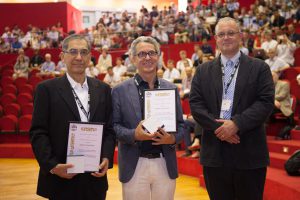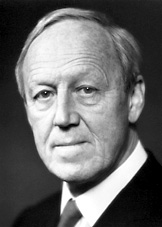For outstanding contributions to plasma physics
The prize was established by the EPS Plasma Physics Division in 2000 and is awarded for research achievements which have either already shaped the field of plasma physics or have demonstrated the potential to do so in future. To recognize collaborative research, a group of up to three individual scientists may be nominated. It is awarded each year at the EPS Conference on Plasma Physics.
The Call for Nominations for the 2025 EPS Hannes Alfvén Prize has now opened: the nomination form can be found here. Please take note of the Statutes of this prize.
Previous prize winners
| Year | Winner(s) |
| 2025 | Michel Koenig (LULI, France) for outstanding and continuous contributions to the experimental study of laser-plasma interactions applied in the domain of laboratory astrophysics, of high-energy density physics, and of inertial confinement fusion. |
| 2024 | Tünde Fülöp (Chalmers University of Technology, Sweden) and Per Helander (Max Planck Institute for Plasma Physics, Greifswald, Germany) for outstanding contributions to theoretical plasma physics, yielding groundbreaking results that significantly impact the understanding and optimization of magnetically confined fusion plasmas. |
| 2023 | Pisin Chen (National Taiwan University, Taipei, Republic of China), James Benjamin Rosenzweig (University of California, Los Angeles, USA) and Chandrashekhar Janardan Joshi (University of California, Los Angeles, USA) for proposing, demonstrating and conducting impressive ground-breaking experiments on plasma wakefield accelerators driven by particle beams, thus firmly establishing the new concept of plasma acceleration and their applications in the scientific community. |
| 2022 | Xavier Garbet (CEA/IRFM, Cadarache, France) for important contributions to the theory of the mesoscopic dynamics of magnetically confined fusion (MCF) plasmas: specifically, to understanding turbulence spreading, flux-driven gyrokinetic simulations, transport barriers, up-gradient transport and edge instabilities |
| 2021 | Sergei Igorevich Krasheninnikov (Department of Mechanical and Aerospace Engineering, University of California San Diego, USA) for seminal contributions to the plasma physics of the scrape-off layer and divertor in magnetically confined fusion (MCF) experiments, including the physics of “blobs”, divertor plasma detachment, and dust, together with atomic physics effects |
| 2020 | Annick Pouquet (Laboratory for Atmospheric and Space Physics, University of Colorado, and National Center for Atmospheric Research, Boulder, Colorado, USA) for fundamental contributions to quantifying energy transfer in magneto-fluid turbulence. Annick Pouquet’s contributions, together with her colleagues, include predicting the inverse cascade of magnetic helicity, extending the accessible frontier of nonlinear numerical computations, and key steps forward in the analytical theory of turbulence. Her work has facilitated remarkable advances in the understanding of turbulence in astrophysical and space plasmas |
| 2019 | Victor Malka (LOA, France, and Weizmann Institute of Science, Israel) for major contributions to the development of compact laser-plasma accelerators, and to their innovative applications to science and society, which span ultra-fast phenomena, accelerator physics, medicine, radiobiology, chemistry and material science, and to Toshiki Tajima for seminal, broad, and novel contributions to plasma physics and plasma-based accelerator physics, including the concept of laser wakefield acceleration. |
| 2018 | Tony Bell (Oxford University) for seminal contributions covering cosmic ray acceleration by shocks, magnetic field amplification by cosmic rays, flux limited electron transport, generation of magnetic field by laser‑produced energetic electrons, collimation of electron beams for inertial fusion, prolific production of electron‑positron pairs |
| 2017 | Ksenia Aleksandrovna Razumova (Kurchatov Institute, Moscow, Russia) for obtaining, for the first time, a macroscopically stable plasma column in a tokamak configuration; this led to the world-wide programme of experimental exploration and development of the tokamak concept for magnetic confinement fusion |
| 2016 | Sergei Bulanov (National Institute for Quantum and Radiological Science and Technology, Japan, and A.M. Prokhorov Institute of General Physics of Russian Academy of Sciences, Russia) and Hartmut Zohm (Max Planck Institute for Plasma Physics, Germany) for their experimental and theoretical contributions to the development of large-scale next-step devices in high-temperature plasma physics research |
| 2015 | Nathaniel J. Fisch for his contributions to the understanding of plasma wave-particle interactions and their applications to efficiently driving currents with radio-frequency waves |
| 2014 | Patrick Mora for decisive results in the field of laser-produced plasma physics, in particular for illuminating descriptions of laser light absorption in plasmas, electron heat transport in steep temperature gradients and plasma expansion dynamics into vacuum |
| 2013 | Miklos Porkolab for his seminal contributions to the physics of plasma waves and his key role in the development of fusion energy |
| 2012 | Eugene N. Parker for his theoretical discovery of the transonically expanding atmosphere in cool stars as a basic phenomenon in the magnetic astrophysical cosmos |
| 2011 | Patrick Diamond, Akira Hasegawa, and Kunioki Mima for laying the foundations of modern numerical transport simulations and key contributions on self-generated zonal flows and flow shear decorrelation mechanisms which form the basis of modern turbulence in plasmas |
| 2010 | Allen Boozer and Jürgen Nührenberg for the formulation and practical application of criteria allowing stellarators to have good fast-particle and neoclassical energy confinement |
| 2009 | Jürgen Meyer-ter-Vehn for his seminal theoretical work in the fields of inertial confinement fusion (ICF), relativistic laser–plasma interaction and laser wakefield electron acceleration. See EuroPhysics News 41/1 (2010) 04 |
| 2008 | Liu Chen, for his many seminal works on Alfvén wave physics in both laboratory and space plasmas, for his continuing contribution of new ideas which have fostered creativity and promoted cross-fertilization in both these areas of research, and for his fundamental contributions in educating a new generation of researchers for which he is an example to emulate |
| 2007 | Friedrich Wagner, for his continuing outstanding contributions to research into fusion by magnetic confinement |
| 2006 | Paul-Henri Rebut, for his pioneering contributions to many topics in magnetic confinement theory and in the design of tokamak devices, many of which are now implemented in the ITER design |
| 2005 | Malcolm Haines, Tom Sanford, and Valentin Smirnov, for their major contributions to the development of the multi-wire array in Z-pinch pulse-power physics; the x-ray yield was rapidly increased to the level of 2 MJ starting with pioneering work on the ‘Angara’ facilities in Russia, through the ‘Saturn’ project in the Sandia Laboratories to the present ‘Z’ device also in Sandia, strongly supported by the rapid evolution of the underlying theory of cylindrical wire-array liner compressio |
| 2004 | Jack Connor, Jim Hastie, and Bryan Taylor, for their seminal contributions to a wide range of issues of fundamental importance to the success of magnetic confinement fusion, including: the development of gyro-kinetic theory; the prediction of the bootstrap current; dimensionless scaling laws; pressure-limiting instabilities, and micro-stability and transport theory |
| 2003 | Vladimir Evgenievitch Fortov for his seminal contributions in the area of non-ideal plasmas and strongly coupled Coulomb systems, and for his pioneering work on the generation and investigation of plasmas under extreme conditions |
| 2002 | Vitaly Shafranov, for his theoretical research on plasma equilibrium and stability and his outstanding contribution to the physics of magnetically confined toroidal plasmas |
| 2001 | Marshall N. Rosenbluth, for his seminal theoretical contributions since the earliest days of fusion research in virtually all aspects of fusion plasma sciences which now form the basis of modern plasma physics |
| 2000 | Radu Balescu, for his outstanding scientific work in the field of statistical physics of charged particles and of controlled fusion |

